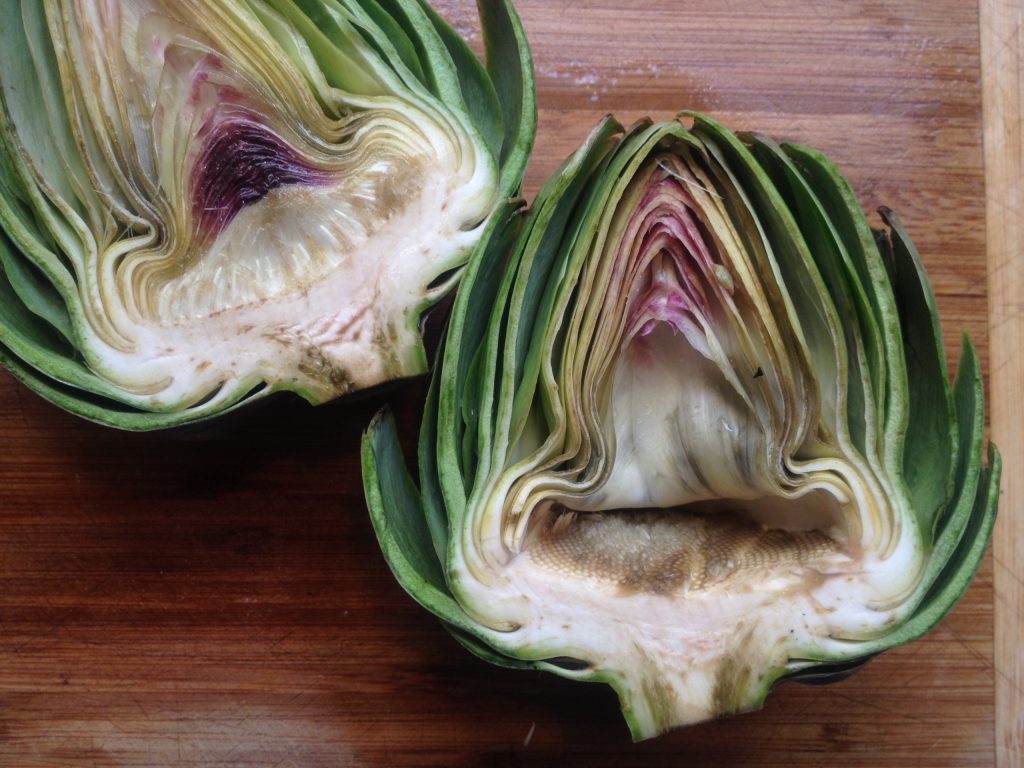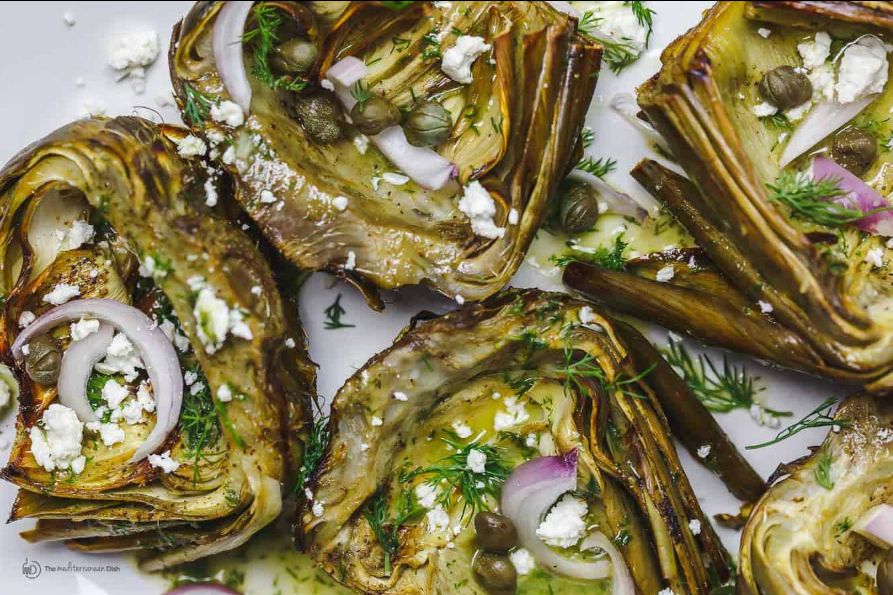When is the last time you bought an artichoke, a whole artichoke, not artichoke hearts in a jar or can? Maybe you’ve never bought a whole artichoke. You’re not alone. When we think of the most popular vegetables, artichokes are probably pretty far down the list. And that’s a shame! Artichokes are delicious, easy to prepare, fun to eat, and chock (choke?) full of benefits. So let’s see what we can do to convince you to add artichokes to your next grocery list.
It’s Not a Vegetable
Often times something we consider a vegetable, tomatoes, pumpkins, eggplants, are actually fruits. Artichokes are similar but instead of being a fruit disguised as a vegetable, they’re a flower disguised as a vegetable!
An artichoke is part of the thistle family and the part of the flower that we eat is an immature flower bud that must be harvested before the flower blooms. When they bloom, they’re spectacular, a big, fluffy purple flower. While artichokes are available in grocery stores year-round in most places, they’re in season in the spring.
Benefits of Artichokes
Gut Health: If you follow nutrition news at all, you’ll know that lately, it’s all about the gut! Gut health is extremely important to our physical and mental health and science is only just beginning to understand just how important. Artichokes are a gut health superstar. A medium artichoke contains 6.8 grams of fiber. They also contain inulin, a type of fiber that is prebiotic. Prebiotics feed the good bacteria in your gut.
Heart Health:
The fiber in artichokes is not only beneficial to the gut but to the heart too! Fiber can help lower blood sugar, blood pressure, bad cholesterol, and inflammation which helps protect your heart.
Cancer Prevention:
Artichokes are loaded with compounds like polyphenols, flavonoids, and antioxidants that can help the immune system fight free radical damage in the body.
Protects the Liver:
Two of the antioxidants in artichokes, silymarin, and cynarin improve liver health by helping to eliminate toxins and waste from the liver itself and the rest of our body. They also help with cell regrowth which helps to repair liver damage.
Low in Calories:
A medium artichoke contains just 60 calories. An added benefit is that it takes a while to eat an artichoke, they’re not something you can gobble down in a few seconds! When it takes longer to eat something, we tend to eat less because it takes time to start to feel full once we start eating.
Aids in Bone Health: Artichokes contain minerals vital to bone health They contain phosphorous, manganese, and magnesium which can help increase bone density thus lowering the risk of developing osteoporosis.
Prevent Birth Defects:
Artichokes contain high levels of folates which can help prevent neural tube defects in babies which is why folic acid is recommended to pregnant women.
Protect Our Brains:
Phosphorous which is a mineral found in artichokes is also found in brain cells. A phosphorous deficiency has been linked to a decline in cognitive ability.

How to Choose an Artichoke
Don’t worry about buying artichokes out of season. Some fruits and vegetables like tomatoes and peaches taste much better during their natural growing season but some others like broccoli and artichokes taste the same year-round. And local doesn’t really apply either as most artichokes are grown in California.
Look for an artichoke that has tightly closed leaves. If the leaves are fanned out, the artichoke is probably not very fresh. Don’t be put off by brown or purple spots. Artichokes are often mottled rather than a uniform color. Some stores sell artichokes with a long portion of the stem remaining rather than just an inch or so that you’ll usually see. If you see long-stemmed artichokes, buy them!
How to Prepare Artichokes
Artichokes can be prepared in several ways but however you cook them, you’ll need to prep them first. Make sure to have a sharp knife on hand as artichokes are rather tough.
Rinse and dry the artichoke.
Cut off about half an inch from the top to expose the inside.
Pull or cut off the errant leaves near the stem.
Cut off the very bottom of the stem. Don’t cut off the whole stem! The stem is edible and in my opinion, it’s the best part.
Use kitchen shears to snip the pointy tip off of the remaining leaves. Be careful, those little points are sharp! How to Cook an Artichoke
Whichever cooking method you prefer, the artichoke is done when you can easily pull a leaf off.
Baked: This is my personal favorite. When you roast an artichoke, it gives it a toasty, nutty flavor. Pull a few leaves back all around the artichoke and place a peeled garlic clove in each little pocket. I use 4 to 6 cloves depending on the size of the artichoke. Place the artichoke on a large piece of tin foil, drizzle with olive oil and sprinkle with good, coarse sea salt. Wrap up the foil, place the artichoke on a baking sheet and bake at 425 degrees for 70 to 80 minutes.
Steaming: Fill a large pot with an inch of water and bring to a boil. Place a steamer basket in the pot, place the artichoke (prepped with garlic as described above) in the basket, cover, reduce the heat to a simmer and cook for 20 to 25 minutes.
Boiling: Fill a large pot with salted water and bring to a boil. Add the artichoke (you can add the garlic cloves but they’ll probably pop out), reduce the heat to a simmer, cover and cook for 20 to 30 minutes.

Eating an Artichoke
Eating artichokes is fun because they’re finger food and who doesn’t like eating with their hands? To eat an artichoke, pull off a leaf, put the bottom of the leaf against your bottom teeth, bite down with your top teeth and scrape the leaf against your bottom teeth. There is a little “meat” in the bottom of each leaf and that’s what you’re after. The rest of the leaf is too fibrous to be edible.
The entire stem can be sliced into circles and eaten, it’s very tender. Once you’ve eaten all of the leaves, you’re getting close to the heart. This is what you see in jars and cans in grocery stores aisles or may have had on a salad or pizza. It’s the most prized part of the artichoke so don’t throw it away by mistake!
Use a spoon to scrape off the prickly, fuzzy covering on the heart and eat that smooth inner part. Like the stem, it’s very tender and you can eat the whole thing.
Artichokes are delicious but made even more delicious when the leaves are dipped in a sauce. The simplest sauce is just to mix some lemon juice and melted butter but my favorite is an indulgent hollandaise made with an orange-yolked, pastured egg. “Real” hollandaise is a bit of an undertaking so I use this short cut recipe and it comes out terrific. The only addition I make is to add a tiny, tiny pinch of cayenne pepper.
Reply to this newsletter or text me at 646-436-5311 to get the PROBIOTIC-based supplements for weight loss, metabolism or other specific health conditions.
